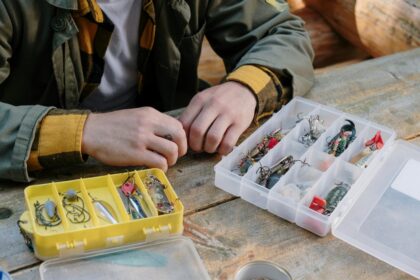© 2024 Adventure Ready Outlet. All rights reserved.


Whether you’re a seasoned angler or just starting out, having the right fishing gear is essential for a successful day on the water. From selecting the right rod and reel to choosing the best lures and lines, there are countless options to consider when it comes to outfitting yourself for a day of fishing. In this blog post, we’ll break down everything you need to know about fishing gear, from the basics to more advanced equipment choices.
Rods: When it comes to selecting a fishing rod, there are several factors to consider, including length, action, and material. Longer rods are great for casting long distances, while shorter rods offer more precision when fishing in tight spaces. Action refers to how much the rod bends when pressure is applied – fast action rods bend less and are great for hooking fish quickly, while slow action rods bend more and provide a more forgiving experience for beginners. Materials like fiberglass and graphite each have their own benefits; fiberglass rods tend to be more durable, while graphite rods are lighter and more sensitive.
Reels: Choosing the right reel is just as important as selecting the right rod. There are three main types of reels – spinning reels, baitcasting reels, and spin cast reels – each with its own advantages and disadvantages. Spinning reels are easy to use and versatile, making them a popular choice for beginners. Baitcasting reels offer greater control over casting distance and accuracy but have a steeper learning curve. Spincast reels are simple and user-friendly but may not be suitable for larger fish or heavy-duty fishing.
Line: Fishing line comes in various materials such as monofilament, fluorocarbon, and braided lines, each with its own strengths and weaknesses. Monofilament line is affordable and easy to work with but has more stretch than other types of line. Fluorocarbon line is virtually invisible underwater and sinks faster than monofilament but can be stiff and prone to tangles if not used correctly. Braided lines are strong and sensitive but can be tricky to tie knots with due to their slick surface.
Lures: Lures come in endless shapes, sizes, colors, and designs designed to attract different types of fish in various conditions. Hard baits like crankbaits mimic injured baitfish swimming erratically through the water while soft plastics imitate worms or insects that fish love to eat. Jigs can be used for bottom fishing or jigging vertically in deep water columns while spinnerbaits create vibrations that attract fish by mimicking wounded prey.
Accessories: In addition to rods, reels, lines, and lures, there are several accessories that can enhance your fishing experience such as tackle boxes for organizing your gear efficiently; landing nets for safely bringing in your catch; polarized sunglasses that reduce glare on the water’s surface; waders or boots for wading into streams or lakes; fillet knives for cleaning your catch; sunscreen; bug spray; first aid kit; pliers or multitools; rain gear; hat or visor.
From selecting the right rod length and action to choosing between spinning reels or baitcasting reels – investing time in researching different types of fishing gear will significantly improve your chances of success on the water. Remember that every angler has their preferences when it comes to equipment choices so don’t be afraid to experiment until you find what works best for you! Whether you’re targeting bass in freshwater lakes or offshore trolling for marlin – having a well-rounded knowledge of fishing gear will set you up for an enjoyable day out on the water.
© 2024 Adventure Ready Outlet. All rights reserved.

